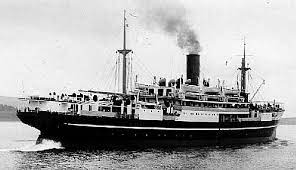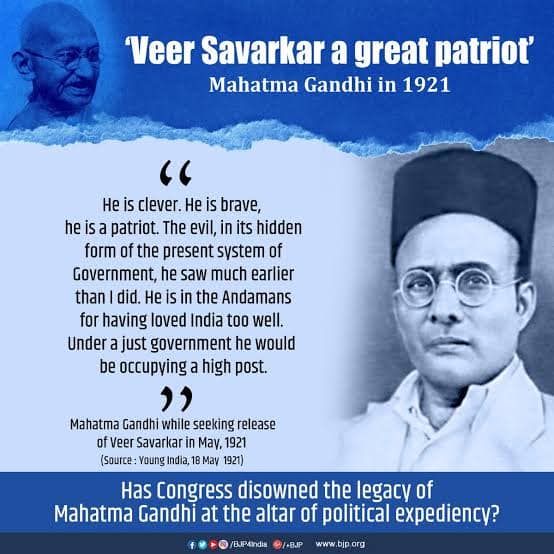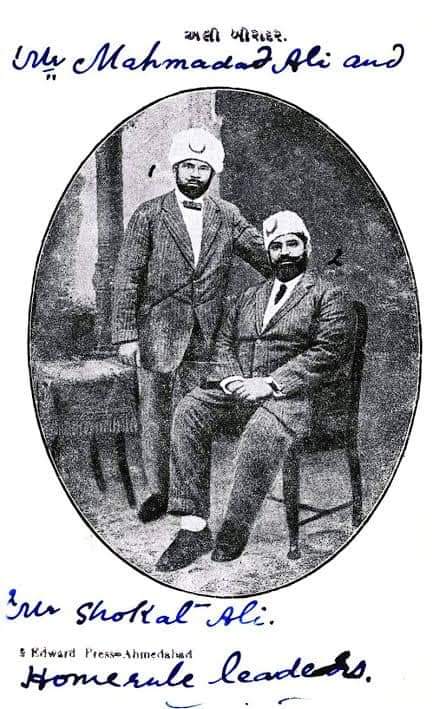
#VEERGATHA – Tribute to Mahapurush Vinayak Damodar Savarkar on his jayanti.
This is a long thread and I write in brief about his time in Cellular Jail and later about Savarkar, a social reformer nobody wants to talk about.
The Guardian Published #SurvivorsOfHell, it gave the

This is a long thread and I write in brief about his time in Cellular Jail and later about Savarkar, a social reformer nobody wants to talk about.
The Guardian Published #SurvivorsOfHell, it gave the


information which Nehruvian Historians suppressed for years..
THE ROLE OF SAVARKAR IN SHAPING ANUSHILAN SAMITHI & THEIR LEGENDARY REVOLUTIONARIES.
Vinayak Savarkar was aboard the SS Maharaja which docked on July 4, 1911, bringing prisoners to the Cellular Jail. The wooden ticket
THE ROLE OF SAVARKAR IN SHAPING ANUSHILAN SAMITHI & THEIR LEGENDARY REVOLUTIONARIES.
Vinayak Savarkar was aboard the SS Maharaja which docked on July 4, 1911, bringing prisoners to the Cellular Jail. The wooden ticket

around his neck declared that he was here to serve a 50-year double life sentence. "I felt that I had entered the jaws of death. The high wall was adorned with a festoon of manacles and several similar instruments of torture were hanging down from the wall," he wrote. 

Savarkar scratched out his story with a nail on to the walls of his cell (No 52, Level Three, Yard Seven Wing. It had a view over the gallows that could hang three men simultaneously). Five years previously, in 1906, Savarkar had been admitted to chambers in London. It was at a 



time when India was on the cusp of another mutiny.
The 50th anniversary of the Lucknow massacre loomed & Lord Curzon's decision to partition Bengal was threatening to destabilise the province. Savarkar, aged 23, took digs in a student hostel in Hampstead; he found it had become
The 50th anniversary of the Lucknow massacre loomed & Lord Curzon's decision to partition Bengal was threatening to destabilise the province. Savarkar, aged 23, took digs in a student hostel in Hampstead; he found it had become
the headquarters for the newly-formed Free India Society. He turned his hand to translating Russian bomb manuals & hollowing out copies of The Pickwick Papers to be filled with guns for India.
The smuggled munitions found their way to student activists such as Indu Bhushan Roy.
The smuggled munitions found their way to student activists such as Indu Bhushan Roy.
Others - like Calcutta student Ullaskar Dutt, who stole chemicals from his father's university laboratory - made their own bombs. In the summer of 1907, the newly armed undergraduates combined forces in an abandoned bungalow in the city's rundown suburb of Maniktola, which was
now a revolutionary school run by Barin Ghose, a dilettante born in Upper Norwood.
The following spring - April 30, 1908, one of Ullaskar Dutt's home made bombs exploded inside a carriage in Muzaffarpur. Instead of assassinating Douglas Kingsford, the chief presidency magistrate
The following spring - April 30, 1908, one of Ullaskar Dutt's home made bombs exploded inside a carriage in Muzaffarpur. Instead of assassinating Douglas Kingsford, the chief presidency magistrate
they killed his bridge partners, Mrs Pringle-Kennedy & her daughter, Grace. Within days, the CID, Britain's fledgling foreign intelligence service, threw a dragnet over Bengal and began arresting the garden conspirators.
Meanwhile, in London, on July 1, 1909,Sir William Curzon
Meanwhile, in London, on July 1, 1909,Sir William Curzon
Wyllie, political aide de camp to the Secretary of State for India, was gunned down on the steps of the Imperial Institute. Vinayak Savarkar, who had been sending arms to the Bengali student revolutionaries, was accused of providing the weapon. He was deported to India and then
transported to the new Cellular Jail, where he found himself incarcerated alongside Prisoner 31549, Barin Ghose, Prisoner 31552, Ullaskar Dutt, and Prisoner 31555, Indu Bhushan Roy.
They recalled how every day, from 6am, David Barry would sit puffing on a cigar, watching them
They recalled how every day, from 6am, David Barry would sit puffing on a cigar, watching them
yoked to a press that they turned until they had produced 30lbs of mustard oil & if the college boys fell sick, there was no sanctuary in the prison hospital, where a new recruit, Dr FA Barker, certified PATIENTS FIT FOR FLOGGING.
Shortly after 2AM on April 29, 1912, the alarm
Shortly after 2AM on April 29, 1912, the alarm

went up on Yard Three Wing. Warden Gulmir had shone his hurricane lamp through the barred door of cell 82 and found an empty bed: "I saw the deceased hanging to the window." It was another six hours before Barker, the prison doctor, arrived.
A telegram giving news of the death
A telegram giving news of the death
was intercepted by Bengali revolutionaries. They published it on the front page of their newspaper, the Amrita Bazar Patrika. Indu Bhushan, they said, had hanged himself with a strand of torn kurta, "exhausted by the unrelenting oil mill".
"I lay on my bed, my eyes riveted on
"I lay on my bed, my eyes riveted on

the barred window," Savarkar scratched on his cell wall. Down the corridor, "troublemaker" Ullaskar Dutt was hanging by his wrists from a peg hammered into the wall above his head, one day into a seven-day punishment for accusing Dr Barker of aiding Roy's death.
Savarkar was the
Savarkar was the
first to hear the cries on June 15 as warders dragged Ullaskar down the Yard Five Wing. "Ullaskar Dutt's gone mad," the shout went up and, according to his log, Dr Barker was waiting when the patient arrived at the jail hospital. He used a device to check if the prisoner was
acting up. "I could feel the metal clips and then his battery playing on my body. The electric current passed through me with the force of lightning," Ullaskar would recall many years later.
The above information is available at British Archives.
Let us learn about the Crusader
The above information is available at British Archives.
Let us learn about the Crusader
SAVARKAR who fought against caste evils.
“I feel the need to rebel against caste discrimination and untouchability as much as I feel the need to fight against foreign occupation of India.”
Vinayak Damodar Savarkar, in a letter to his brother Narayanrao in 1920, described his
“I feel the need to rebel against caste discrimination and untouchability as much as I feel the need to fight against foreign occupation of India.”
Vinayak Damodar Savarkar, in a letter to his brother Narayanrao in 1920, described his
thoughts on caste-based discrimination.
One of the most influential figures in modern Indian history, Vinayak Damodar Savarkar, has often been demonised by his detractors who project him as a Hindu fundamentalist while his supporters often treat him as an Hindutva icon. However
One of the most influential figures in modern Indian history, Vinayak Damodar Savarkar, has often been demonised by his detractors who project him as a Hindu fundamentalist while his supporters often treat him as an Hindutva icon. However
one of the least discussed aspects of Savarkar’s life pertains to his efforts as a social reformer, especially against caste discrimination and untouchability.
After undergoing nearly 15 years of torturous imprisonment in the Andamans, Savarkar focused on social reforms after
After undergoing nearly 15 years of torturous imprisonment in the Andamans, Savarkar focused on social reforms after
his release. He wanted to eradicate the indigenous practices that were creating differences in Bharatiya society. Savarkar once said, “He who gives up verbosity and acts as per the principle of ‘irrespective of whether others do it or not, as far as I am concerned, I will
practice reform on a daily basis’ alone is a true reformer.” (‘Hindutvache panchapran’ or The Spirit of Hindutva; Samagra Savarkar Vangmaya, edited by SR Date, Vol. 3, p.75).
Savarkar was a strong critic of the caste system & ensured that children of the so-called lower castes
Savarkar was a strong critic of the caste system & ensured that children of the so-called lower castes
attend school. He gave monetary incentives to their parents and distributed slate and chalk to children from these castes. Savarkar said, “Once the children are educated together, they will not observe caste hierarchy in later life. They will not feel the need to observe caste
division. In addition, the government should abandon the title ‘special schools for low caste children’. This very title creates a feeling of inferiority among children attending the school.”
On Hindu festivals like Dussehra and Makar Sakranti, Savarkar would visit houses
On Hindu festivals like Dussehra and Makar Sakranti, Savarkar would visit houses
accompanied by people from different castes, and distribute traditional sweets. He himself brought up a girl child from a former untouchable community and taught people from untouchable communities to read, write and recite the Gayatri mantra.
THREAD CONTINUES
THREAD CONTINUES
In 1930, Savarkar started the first pan-Hindu Ganeshotsav. The festivities would be marked by “kirtans” rendered by the so-called untouchables. Listeners from the so-called higher castes would garland those who rendered these devotional songs. Public lectures by women and
inter-caste dining by women were special features of these festivities. Savarkar was also behind many temple movements of Maharashtra, where the untouchables were encouraged to pray, recite Sanskrit hymns and conduct “abhishek” of the Vishnu Vigraha.
In 1931, the Patitpavan
In 1931, the Patitpavan
mandir was established in Ratnagiri; it had on its trust, representation from all castes, including those from the erstwhile untouchable caste. Savarkar also organised community meals in some temples. The first community meal for women in Maharashtra was held in the Patitpavan 



mandir on September 21, 1931. Around 75 women were present on the occasion. By 1935, this count had gone up to 400.
On May 1, 1933, Savarkar started a cafe for Hindus of all castes, including untouchables. This was the first pan-Hindu café in entire India. He had employed a
On May 1, 1933, Savarkar started a cafe for Hindus of all castes, including untouchables. This was the first pan-Hindu café in entire India. He had employed a
person from the Mahar caste to serve food there. This was at a time when inter-caste dining was unthinkable.
Criticising the practice of caste being decided by birth, Savarkar said: “There is a belief that heredity, birth in a particular caste decides what qualities a person
Criticising the practice of caste being decided by birth, Savarkar said: “There is a belief that heredity, birth in a particular caste decides what qualities a person
imbibes… A person who has no qualities of a Brahmin…whose seven generations have not shown any qualities expected of a Brahmin is called a Brahmin because one of his forefathers, maybe 70 generations ago, possessed those qualities. He or she has the privileges of a Brahmin
simply because they are born in that family. And a person born to a family considered as a lower caste is an untouchable just because some of his forefathers 70 generations ago had performed a job that was considered lowly. This system of deciding caste by birth is so unjust,
damaging and an hindrance to the progress of humanity.” Savarkar argued that such a system should be abolished.
Savarkar also talked about the ways to abolish the caste system and untouchability, He said, “To achieve social revolution we first have to strike at the birth-based
Savarkar also talked about the ways to abolish the caste system and untouchability, He said, “To achieve social revolution we first have to strike at the birth-based
caste system and bridge the differences between the various castes” (Samagra Savarkar Vangmay; Part 3, page 641).
He was a proponent of a united India, which was inclusive and diverse — an India that was an organic result of all its diverse cultures. He believed in the idea of
He was a proponent of a united India, which was inclusive and diverse — an India that was an organic result of all its diverse cultures. He believed in the idea of
inclusivity for mobilising the Indian masses. Some oppositional forces have, generally, made skewed arguments by terming him as the proponent of the two-nation theory, by referring to parts of his presidential address of the 19th Hindu Mahasabha session in Karnavati (Ahmedabad)
in 1937. This is far from the truth. During the 21st annual session of the Hindu Mahasabha held in Calcutta in 1939, Savarkar, in his presidential address, spoke about how the Hindus and Muslims could bury their historical differences in a common Hindustani constitutional state.
Savarkar also openly embraced the “Era of Machines” and warned the Indian leaders to learn from Europe’s mistakes. Not many are aware that traditional Hindutvawadis despised Savarkar for his modern approach to life. He bluntly wrote how “India is 200 years behind Europe” and has
to give up its religious discourse if it wants to catch up with the modern world.
Some of his criticism of Hindu traditions is so harsh and direct that it can be found “unprintable”. In an another essay, he came down heavily on the Hindu caste system and questioned “upper caste”
Some of his criticism of Hindu traditions is so harsh and direct that it can be found “unprintable”. In an another essay, he came down heavily on the Hindu caste system and questioned “upper caste”
Hindus who won’t mind consuming cow-urine and cow-dung but at the same time refuse to accept a glass of water from the hands of the supremely intellectual Ambedkar.
His futuristic approach to Indian cinema, too, was commendable. He believed in the innovative spirit of the human
His futuristic approach to Indian cinema, too, was commendable. He believed in the innovative spirit of the human
mind. He was a multidimensional personality and wore many hats: A freedom fighter, social reformer, writer, poet, historian, political leader and philosopher. Biased historiography has led to the building of a controversial narrative with a superficial understanding of Savarkar.
Veer Savarkar’s crusade against caste discrimination remains under-appreciated
There are several aspects of this great revolutionary, reformer and visionary which demand greater attention.

There are several aspects of this great revolutionary, reformer and visionary which demand greater attention.


• • •
Missing some Tweet in this thread? You can try to
force a refresh


















